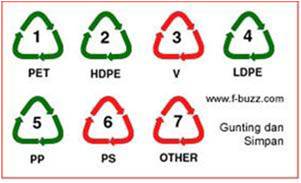IDENTIFY THE HAZARDS AND TYPES OF THE SAFE PLASTIC PACKAGING
05/06/2020 Views : 605
Muliani
Plastic has become a part of people's daily lives. As much as 80% of plastic is used to package food in Indonesia, especially the use for flexle packaging reaches 53%.[1] Household appliances are also often made of plastic but the composition and quality of the plastic used is not suitable and dangerous for health. This paper aims to make people aware of the hazards and types of the safe plastic packaging.[2-4]
Plastic consists of additives phthalate and bisphenol-A (BPA). Both can migrate and contaminate food and drink that packaged in plastics.[3-6]
This contaminated food and drink is dangerous for health. They are carcinogenic, disrupt the reproductive and endocrine systems, damage of the liver, kidneys, testes and thyroid, increase the risk of allergies and neurological development disorders of the children.[5-7] Burning plastic waste can also result in the release of dioxin which is harmful to health and environment.[2]
The requirements for plastic as safe food packaging are as follows: non toxic, migrate and leave residue in food or food packaging, not pollute the environment, able to maintain the shape, taste, cleanliness and nutrition of the food ingredients.[8]
Generally, there is code that listed on the plastic. This code shows the types of polymers used in making plastics. The type of polymer will determine the nature, safety and usefulness of the plastic.[3]There are seven plastic codes, as in the following picture

Figure 1. The codes that are listed on the plastic.[3]
Code 5 contains polypropylene (PP). is resistant to chemicals, strong, has a high melting point, safe also suitable for storing food and drinks and can be used repeatedly.[3]
Glass or ceramic packaging is recommended.[1,3,9] Plastic packaging as a last option is used if there are producer identities, code 5, natural color, according to the manufacturer's instructions. Drinking bottles and children lunch containers should use safe plastic (code 5) and in accordance with the Indonesian National Standard (SNI).[9]
References
1. Sulchan, M., Nur, E. 2007. Keamanan pangan kemasan plastic dan Styrofoam. Maj Kedokt Indon, 57(2): 54-59.
2. Verma, R., Vinoda, KS., Papireddy, M., Gowdy, ANS. 2016. Toxic pollutants from plastic waste– a review. Procedia Environmental Sciences, 35: 701 – 708. doi:10.1016/j.proenv.2016.07.069
3. Karuniastuti, N. tt. Bahaya plastik terhadap kesehatan dan lingkungan. Forum Teknologi, 3(1): 6-14.
4. Rustagi, N., Pradhan, SK., Singh, R. 2011. Public health impact of plastics: An overview. Indian J Occup Environ Med. 15(3): 100–103. doi:10.4103/0019-5278.93198
5. Joseph, N., Kumar, A., Majgi, SM., Kumar GS., Prahalad RBY. 2016. Usage of plastic bags and health hazards: a study to assess awareness level and perception about legislation among a small population of Mangalore City. Journal of Clinical and Diagnostic Research, 10(4): LM01-LM04
6. Ilmiawati, C., Reza, M., Rahmatini, Rustam, E. 2017. Edukasi pemakaian plastik sebagai kemasan makanan dan minuman serta risikonya terhadap kesehatan pada komunitas di Kecamatan Bungus Teluk Kabung, Padang. Jurnal Ilmiah Pengabdian kepada Masyarakat, 1(1): 20-28
7. Inadera, H. 2015. Neurological Effects of Bisphenol A and its Analogues. Int. J. Med. Sci., 12(12): 926-936. doi: 10.7150/ijms.13267
8. Mukhtar, S., Nurif, M. 2015. Peranan packaging dalam meningkatkan hasil produksi terhadap konsumen. JSH, 8(2): 181-191.
9. Homan, DK. 2011. Simbol untuk menunjang sistem informasi desain kemasan makanan dan minuman plastik. Humaniora, 2(1): 33-39
